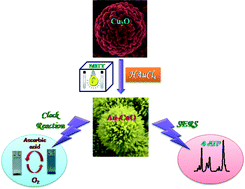Hierarchical Au–CuO nanocomposite from redox transformation reaction for surface enhanced Raman scattering and clock reaction†
Abstract
Electrochemical processing has already manifested its prominence for obtaining well structured composite materials. The method is highly precise and is reduction potential driven. This methodology has resulted in a hierarchical Au–CuO nanocomposite from a chosen redox transformation reaction between the newly synthesized spherical and roughened Cu2O nanoparticles and HAuCl4. Thus the attractive shape as well as reducing capability of Cu2O made it promising as a starting material. The proposed redox transformation reaction does not need any additional reducing or stabilizing agents. The reduction potential value of CuO/Cu2O (+0.66 V vs. SHE) supports the quantitative reduction of Au(III) ions because of its higher reduction potential (+1.69 V vs. SHE) i.e., for the AuCl4−/Au half cell. The prescribed conditions, spontaneous redox reaction and the morphology of Cu2O nanoparticles help to produce the unique Au–CuO nanoflowers. The formation of Au–CuO nanocomposites from Cu2O nanospheres is characterised by several physical techniques such as XRD, XPS and FTIR. Finally the flower like Au–CuO nanocomposite shows higher SERS activity with 4-aminothiophenol (4-ATP) as a probe molecule than what is evident from the individual components (Au or Cu2O or CuO). Additionally the derived Au–CuO nanocomposite has also been found to be an effective catalyst for the clock reaction employing methylene blue and ascorbic acid in solution.


 Please wait while we load your content...
Please wait while we load your content...